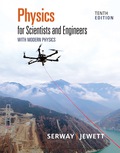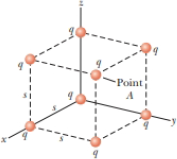
EBK PHYSICS FOR SCIENTISTS AND ENGINEER
10th Edition
ISBN: 8220106740163
Author: SERWAY
Publisher: CENGAGE L
expand_more
expand_more
format_list_bulleted
Concept explainers
Textbook Question
Chapter 22, Problem 48CP
Eight charged panicles, each of magnitude q, are located on the corners of a cube of edge s as shown in Figure P22.48. (a) Determine the x, y, and z components of the total force exerted by the other charges on the charge located at point A. What are (b) the magnitude and (c) the direction of this total force?
Figure P22.48

Expert Solution & Answer
Want to see the full answer?
Check out a sample textbook solution
Students have asked these similar questions
2. List three places besides in springs where Hooke's law applies.
1. What is the spring constant of a spring that starts 10.0 cm long and extends to 11.4 cm with a 300 g mass hanging from it?
please help me solve all parts of this question from physics. thanks so much in advance! :)))
Chapter 22 Solutions
EBK PHYSICS FOR SCIENTISTS AND ENGINEER
Ch. 22.1 - Three objects are brought close to each other, two...Ch. 22.2 - Three objects are brought close to one another,...Ch. 22.3 - Object A has a charge of +2 C, and object B has a...Ch. 22.4 - A test charge of +3 C is at a point P where an...Ch. 22.5 - Rank the magnitudes of the electric field at...Ch. 22 - Find to three significant digits the charge and...Ch. 22 - (a) Find the magnitude of the electric force...Ch. 22 - In a thundercloud, there may be electric charges...Ch. 22 - Nobel laureate Richard Feynman (19181088) once...Ch. 22 - A 7.50-nC point charge is located 1.80 m from a...
Ch. 22 - This afternoon, you have a physics symposium...Ch. 22 - Two small beads having positive charges q1 = 3q...Ch. 22 - Two small beads having charges q1 and q2 of the...Ch. 22 - Review. In the Bohr theory of the hydrogen atom,...Ch. 22 - Three point charges lie along a straight line as...Ch. 22 - A point charge +2Q is at the origin and a point...Ch. 22 - Particle A of charge 3.00 104 C is at the origin,...Ch. 22 - Review. Two identical particles, each having...Ch. 22 - Why is the following situation impossible? Two...Ch. 22 - What are the magnitude and direction of the...Ch. 22 - Consider n equal positively charged particles each...Ch. 22 - Two equal positively charged particles are at...Ch. 22 - Two charged particles are located on the x axis....Ch. 22 - Three point charges are located on a circular arc...Ch. 22 - Two 2.00-C point charges are located on the x...Ch. 22 - Three point charges are arranged as shown in...Ch. 22 - Consider the electric dipole shown in Figure...Ch. 22 - Three equal positive charges q are at the corners...Ch. 22 - A proton accelerates from rest in a uniform...Ch. 22 - A proton moves at 4.50 105 m/s in the horizontal...Ch. 22 - Protons are projected with an initial speed vi =...Ch. 22 - You are still fascinated by the process of inkjet...Ch. 22 - You are working on a research project in which you...Ch. 22 - Consider an infinite number of identical...Ch. 22 - A particle with charge 3.00 nC is at the origin,...Ch. 22 - A small block of mass m and charge Q is placed on...Ch. 22 - A small sphere of charge q1 = 0.800 C hangs from...Ch. 22 - A charged cork ball of mass 1.00 g is suspended on...Ch. 22 - A charged cork ball of mass m is suspended on a...Ch. 22 - Three charged particles are aligned along the x...Ch. 22 - Two point charges qA = 12.0 C and qB = 45.0 C and...Ch. 22 - Two small spheres hang in equilibrium at the...Ch. 22 - Four identical charged particles (q = +10.0 C) are...Ch. 22 - Review. Two identical blocks resting on a...Ch. 22 - Review. Two identical blocks resting on a...Ch. 22 - Three identical point charges, each of mass m =...Ch. 22 - Why is the following situation impossible? An...Ch. 22 - Two hard rubber spheres, each of mass m = 15.0 g,...Ch. 22 - Two identical beads each have a mass m and charge...Ch. 22 - Two small spheres of mass m are suspended from...Ch. 22 - You are working as an expert witness for an...Ch. 22 - Review. A 1.00-g cork ball with charge 2.00 C is...Ch. 22 - Eight charged panicles, each of magnitude q, are...Ch. 22 - Two particles, each with charge 52.0 nC, are...Ch. 22 - Review. An electric dipole in a uniform horizontal...
Knowledge Booster
Learn more about
Need a deep-dive on the concept behind this application? Look no further. Learn more about this topic, physics and related others by exploring similar questions and additional content below.Similar questions
- A fluid with density 263 kg/m3 flows through a pipe of varying diameter and height. At location 1 the flow speed is 13.5 m/s and the diameter of the pipe is 7.4 cm down to location 2 the pipe diameter is 16.9 cm. Location 1 is 6.3 meters higher than location 2. What is the difference in pressure P2 - P1? Using units in Pascals and use g = 9.81 m/s2.arrow_forwardThe kitchen had a temperature 46 degrees Fahrenheit and was converted it to Kelvin. What is the correct number for this temperature (46 F) on the Kelvin scale?arrow_forwardWater is traveling at a speed of 0.65 m/s through a pipe with a cross-section radius of 0.23 meters. The water enters a section of pipe that has a smaller radius, only 0.11 meters. What is the speed of the water traveling in this narrower section of pipe?arrow_forward
- A particular water pipe has a radius of 0.28 meters. If the pipe is completely filled with water, moving with average velocity 0.45 m/s, what is the flow rate of water through the pipe with units of cubic meters of water per second?arrow_forwardWater is flowing through a horizontal pipe with two segments. In one segment, the water flows at a speed v1 = 4.52 m/s. In the second segment the speed of the water is v2 = 2.38 m/s. Based on Bernoulli's Principle, what is the difference in pressure (P2 - P1) between the two segments? Assume that the density of the water is 997 kg/m3 and give your answer as the number of Pascals (i.e. N/m2).arrow_forwardWater from the faucet is supplied to the hose at a rate of 0.00057 m3/s. At what speed (number of meters per second) does the water exit the nozzle if the cross sectional area of the narrow nozzle is 2.1 x 10-6 m2?arrow_forward
- Jason Fruits/Indiana University Research Communications Silver/ silver oxide Zinc zinc/oxidearrow_forwardCar P moves to the west with constant speed v0 along a straight road. Car Q starts from rest at instant 1, and moves to the west with increasing speed. At instant 5, car Q has speed w0 relative to the road (w0 < v0). Instants 1-5 are separated by equal time intervals. At instant 3, cars P and Q are adjacent to one another (i.e., they have the same position). In the reference frame o f the road, at instant 3 i s the speed o f car Q greater than, less than, or equal to the speed of car P? Explain.arrow_forwardCar P moves to the west with constant speed v0 along a straight road. Car Q starts from rest at instant 1, and moves to the west with increasing speed. At instant 5, car Q has speed w0 relative to the road (w0 < v0). Instants 1-5 are separated by equal time intervals.arrow_forward
- Car P moves to the west with constant speed v0 along a straight road. Car Q starts from rest at instant 1, and moves to the west with increasing speed. At instant 5, car Q has speed w0 relative to the road (w0 < v0). Instants 1-5 are separated by equal time intervals. Sketch and label a vector diagram illustrating the Galilean transformation of velocities that relates velocity of car P relative to the road, velocity of car Q relative to road, and velocity of car Q relative to car P at instant 3. In the frame of car P, at instant 3 is car Q moving to the west, moving to the east, or at rest? Explain.arrow_forwardJust 5 and 6 don't mind 7arrow_forwardIn an electron gun, electrons are accelerated through a region with an electric field of magnitude 1.5 × 104 N/C for a distance of 2.5 cm. If the electrons start from rest, how fast are they moving after traversing the gun?arrow_forward
arrow_back_ios
SEE MORE QUESTIONS
arrow_forward_ios
Recommended textbooks for you
 Physics for Scientists and Engineers: Foundations...PhysicsISBN:9781133939146Author:Katz, Debora M.Publisher:Cengage Learning
Physics for Scientists and Engineers: Foundations...PhysicsISBN:9781133939146Author:Katz, Debora M.Publisher:Cengage Learning Physics for Scientists and EngineersPhysicsISBN:9781337553278Author:Raymond A. Serway, John W. JewettPublisher:Cengage Learning
Physics for Scientists and EngineersPhysicsISBN:9781337553278Author:Raymond A. Serway, John W. JewettPublisher:Cengage Learning Physics for Scientists and Engineers with Modern ...PhysicsISBN:9781337553292Author:Raymond A. Serway, John W. JewettPublisher:Cengage Learning
Physics for Scientists and Engineers with Modern ...PhysicsISBN:9781337553292Author:Raymond A. Serway, John W. JewettPublisher:Cengage Learning Principles of Physics: A Calculus-Based TextPhysicsISBN:9781133104261Author:Raymond A. Serway, John W. JewettPublisher:Cengage Learning
Principles of Physics: A Calculus-Based TextPhysicsISBN:9781133104261Author:Raymond A. Serway, John W. JewettPublisher:Cengage Learning College PhysicsPhysicsISBN:9781305952300Author:Raymond A. Serway, Chris VuillePublisher:Cengage Learning
College PhysicsPhysicsISBN:9781305952300Author:Raymond A. Serway, Chris VuillePublisher:Cengage Learning College PhysicsPhysicsISBN:9781285737027Author:Raymond A. Serway, Chris VuillePublisher:Cengage Learning
College PhysicsPhysicsISBN:9781285737027Author:Raymond A. Serway, Chris VuillePublisher:Cengage Learning

Physics for Scientists and Engineers: Foundations...
Physics
ISBN:9781133939146
Author:Katz, Debora M.
Publisher:Cengage Learning

Physics for Scientists and Engineers
Physics
ISBN:9781337553278
Author:Raymond A. Serway, John W. Jewett
Publisher:Cengage Learning

Physics for Scientists and Engineers with Modern ...
Physics
ISBN:9781337553292
Author:Raymond A. Serway, John W. Jewett
Publisher:Cengage Learning

Principles of Physics: A Calculus-Based Text
Physics
ISBN:9781133104261
Author:Raymond A. Serway, John W. Jewett
Publisher:Cengage Learning

College Physics
Physics
ISBN:9781305952300
Author:Raymond A. Serway, Chris Vuille
Publisher:Cengage Learning

College Physics
Physics
ISBN:9781285737027
Author:Raymond A. Serway, Chris Vuille
Publisher:Cengage Learning
Electric Fields: Crash Course Physics #26; Author: CrashCourse;https://www.youtube.com/watch?v=mdulzEfQXDE;License: Standard YouTube License, CC-BY